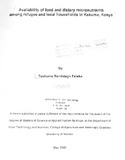| dc.description.abstract | A cross-sectional study that compared two groups of populations, refugees and local residents, was undertaken in Kakuma, Kenya. The study aimed at determining the ade- quacy of food intake and the availability of dietary micronutrients among refugees com- pared to the neighboring local residents. The study was conducted at household level from November 1998 to February 1999. Three hundred subjects i.e., 150 refugees and
150 locals were selected by stratified random sampling methodology. A pre-tested questionnaire was exercised in all households to elicit information on demography, so- cia-economic status and food intake. Two 24-hour recall were exercised to estimate the amount of energy and nutrient intake. Four visits were made to each household to measure frequencies of certain common food items at household level.
The results revealed that refugees consumed more diversified diet than local residents did. However, refugees' food was quite bulky with a low energy density. Local residents consumed more food items from animal origin than refugees did. However, there was no difference for energy intake in both population groups. But, about two-fifth of both the study household groups consumed energy levels below the survival level of 1,500- kcal/adult equivalenUday. More than a quarter of population in both groups was at risk of Vitamin A C and iron deficiency. Generally, the quantity and quality of food intake implies that the study populations are at increased risk of being malnourished.
:xiv
Refugees living in the Kakuma camp have shown a symbiotic relationship with neigh boring residents. Refugees manage to increase diversity in the food intake through selling or exchange of their ration. On the other hand, locals manage to get cheaper and better quality foods, and sell their services or goods to the refugees.
It is recommended that refugees should be given proper training and nutrition educa tion so that instead of selling their ration, they can consume it to meet their nutrient re quirement. Fortification of the food ration (especially with Vitamin A and iron) can also improvemicronutrients intake of refugees living in the Kakuma camp. | en |

